Adaptive Robust Fuzzy Impedance Control of an Electro-Hydraulic Actuator
Abstract
:1. Introduction
2. System Modeling
3. Fuzzy Impedance Control
4. Adaptive Robust Velocity Control
4.1. Model Analysis
4.2. Projection Mapping and Parameter Adaptation
4.3. Velocity Control Design
4.4. Stability of ARC
5. Stability Analysis of the Whole System
6. Experimental Results
7. Conclusions
Author Contributions
Funding
Institutional Review Board Statement
Informed Consent Statement
Data Availability Statement
Conflicts of Interest
References
- Sha, D.; Bajic, V.B.; Yang, H. New model and sliding mode control of hydraulic elevator velocity tracking system. Simulat. Pract. Theory 2002, 9, 365–385. [Google Scholar] [CrossRef]
- Yang, H.; Yang, J.; Xu, B. Computational simulation and experimental research on speed control of VVVF hydraulic elevator. Control Eng. Pract. 2004, 12, 563–568. [Google Scholar]
- Nam, Y.; Hong, S.K. Force control system design for aerodynamic load simulator. Control Eng. Pract. 2002, 10, 549–558. [Google Scholar] [CrossRef]
- Truong, D.Q.; Ahn, K.K. Force control for hydraulic load simulator using self-tuning grey predictor—Fuzzy PID. Mechatronics 2009, 19, 233–246. [Google Scholar] [CrossRef]
- Sirouspour, M.R.; Salcudean, S.E. Nonlinear control of hydraulic robots. IEEE Trans. Rob. Autom. 2001, 17, 173–182. [Google Scholar] [CrossRef]
- Zhu, W.-H.; Piedboeuf, J.-C. Adaptive Output Force Tracking Control of Hydraulic Cylinders with Applications to Robot Manipulators. J. Dyn. Syst. Meas. Control 2005, 127, 206. [Google Scholar] [CrossRef]
- Guo, K.; Pan, Y.; Yu, H. Composite Learning Robot Control with Friction Compensation: A Neural Network-Based Approach. IEEE Trans. Ind. Electron. 2019, 66, 7841–7851. [Google Scholar] [CrossRef]
- Guo, K.; Pan, Y.; Zheng, D.; Yu, H. Composite learning control of robotic systems: A least squares modulated approach. Automatica 2020, 111, 108612. [Google Scholar] [CrossRef]
- Farivarnejad, H.; Moosavian, S.A.A. Multiple Impedance Control for object manipulation by a dual arm underwater vehicle–manipulator system. Ocean. Eng. 2014, 89, 82–98. [Google Scholar] [CrossRef]
- Wang, T.; Li, Y.; Zhang, J.; Zhang, Y. A novel bilateral impedance controls for underwater tele-operation systems. Appl. Soft Comput. 2020, 91, 106194. [Google Scholar] [CrossRef]
- Wang, Q.; Xie, X.; Shahrour, I.; Huang, Y. Use of deep learning, denoising technic and cross-correlation analysis for the prediction of the shield machine slurry pressure in mixed ground conditions. Autom. Constr. 2021, 128, 103741. [Google Scholar] [CrossRef]
- Zhang, H.; Fang, J.; Yu, H.; Hu, H.; Yang, Y. Disturbance observer-based adaptive position control for a cutterhead anti-torque system. PLoS ONE 2022, 17, e0268897. [Google Scholar] [CrossRef] [PubMed]
- Hogan, N. Impedance control: An approach to manipulation: Part I—Theory. J. Dyn. Syst. Meas. Control 1985, 107, 1–7. [Google Scholar] [CrossRef]
- Hogan, N. Impedance control: An approach to manipulation: Part II—Implementation. J. Dyn. Syst. Meas. Control 1985, 107, 8–16. [Google Scholar] [CrossRef]
- Hogan, N. Impedance Control: An Approach to Manipulation: Part III—Applications. J. Dyn. Syst. Meas. Control 1985, 107, 17–24. [Google Scholar] [CrossRef]
- Jamwal, P.K.; Hussain, S.; Ghayesh, M.H.; Rogozina, S.V. Impedance Control of an Intrinsically Compliant Parallel Ankle Rehabilitation Robot. IEEE Trans. Ind. Electron. 2016, 63, 3638–3647. [Google Scholar] [CrossRef]
- Hyun, D.J.; Seok, S.; Lee, J.; Kim, S. High speed trot-running: Implementation of a hierarchical controller using proprioceptive impedance control on the MIT Cheetah. Int. J. Robot Res. 2014, 33, 1417–1445. [Google Scholar] [CrossRef]
- Zhang, J.; Liu, W.; Gao, L.E.; Li, L.; Li, Z. The master adaptive impedance control and slave adaptive neural network control in underwater manipulator uncertainty teleoperation. Ocean. Eng. 2018, 165, 465–479. [Google Scholar] [CrossRef]
- Michel, Y.; Rahal, R.; Pacchierotti, C.; Giordano, P.R.; Lee, D. Bilateral Teleoperation With Adaptive Impedance Control for Contact Tasks. IEEE Robot. Autom. Lett. 2021, 6, 5429–5436. [Google Scholar] [CrossRef]
- Hu, H.; Cao, J. Adaptive variable impedance control of dual-arm robots for slabstone installation. ISA Trans. 2022, 128, 397–408. [Google Scholar] [CrossRef]
- Zhao, X.; Han, S.; Tao, B.; Yin, Z.; Ding, H. Model-Based Actor–Critic Learning of Robotic Impedance Control in Complex Interactive Environment. IEEE Trans. Ind. Electron. 2022, 69, 13225–13235. [Google Scholar] [CrossRef]
- Plummer, A.R. Feedback linearization for acceleration control of electrohydraulic actuators. Proc. Inst. Mech. Eng. Part I J. Syst. Contr. Eng. 2005, 211, 395–406. [Google Scholar] [CrossRef]
- Daher, N.; Ivantysynova, M. An Indirect Adaptive Velocity Controller for a Novel Steer-by-Wire System. J. Dyn. Syst. Meas. Control. Trans. ASME 2014, 136, 051012. [Google Scholar] [CrossRef]
- Ahn, K.K.; Nam, D.N.C.; Jin, M. Adaptive Backstepping Control of an Electrohydraulic Actuator. IEEE/ASME Trans. Mech. 2014, 19, 987–995. [Google Scholar] [CrossRef]
- Zhu, D. Sliding mode synchronous control for fixture clamps system driven by hydraulic servo systems. Proc. Inst. Mech. Eng. C J. Mec. 2007, 221, 1039–1045. [Google Scholar]
- Lin, Y.; Shi, Y.; Burton, R. Modeling and robust discrete-time sliding-mode control design for a fluid power electrohydraulic actuator (EHA) system. IEEE/ASME Trans. Mech. 2013, 18, 1–10. [Google Scholar] [CrossRef]
- Yao, B.; Tomizuka, M. Adaptive robust control of SISO nonlinear systems in a semi-strict feedback form. Automatica 1997, 33, 893–900. [Google Scholar] [CrossRef]
- Yao, B.; Bu, F.P.; Reedy, J.; Chiu, G.T.C. Adaptive robust motion control of single-rod hydraulic actuators: Theory and experiments. IEEE/ASME Trans. Mech. 2000, 5, 79–91. [Google Scholar]
- Chen, Z.; Yao, B.; Wang, Q.F. Accurate Motion Control of Linear Motors With Adaptive Robust Compensation of Nonlinear Electromagnetic Field Effect. IEEE/ASME Trans. Mech. 2013, 18, 1122–1129. [Google Scholar] [CrossRef]
- Zhang, Q.; Fang, J.H.; Wei, J.H.; Xiong, Y.; Wang, G. Adaptive robust motion control of a fast forging hydraulic press considering the nonlinear uncertain accumulator model. Proc. Inst. Mech. Eng. Part I J. Syst. Contr. Eng. 2016, 230, 483–497. [Google Scholar] [CrossRef]
- Chen, S.; Chen, Z.; Yao, B.; Zhu, X.; Zhu, S.; Wang, Q.; Song, Y. Adaptive robust cascade force control of 1-DOF hydraulic exoskeleton for human performance augmentation. IEEE/ASME Trans. Mech. 2017, 22, 589–600. [Google Scholar] [CrossRef]
- Chen, W.H. Disturbance observer based control for nonlinear systems. IEEE/ASME Trans. Mech. 2004, 9, 706–710. [Google Scholar] [CrossRef]
- Guo, K.; Wei, J.H.; Fang, J.H.; Feng, R.L.; Wang, X.C. Position tracking control of electro-hydraulic single-rod actuator based on an extended disturbance observer. Mechatronics 2015, 27, 47–56. [Google Scholar] [CrossRef]
- Li, S.Z.; Wei, J.H.; Guo, K.; Zhu, W.L. Nonlinear Robust Prediction Control of Hybrid Active-Passive Heave Compensator with Extended Disturbance Observer. IEEE Trans. Ind. Electron. 2017, 64, 6684–6694. [Google Scholar] [CrossRef]
- Wei, J.; Zhang, Q.; Li, M.; Shi, W. High-performance motion control of the hydraulic press based on an extended fuzzy disturbance observer. Proc. Inst. Mech. Eng. Part I J. Syst. Contr. Eng. 2016, 230, 1044–1061. [Google Scholar] [CrossRef]
- Zhang, Q.; Wei, J.; Fang, J.; Li, M. Nonlinear motion control of the hydraulic press based on an extended piecewise disturbance observer. Proc. Inst. Mech. Eng. Part I J. Syst. Contr. Eng. 2016, 230, 830–850. [Google Scholar] [CrossRef]
- Shi, W.; Wei, J.; Fang, J.; Li, M. Nonlinear cascade control of high-response proportional solenoid valve based on an extended disturbance observer. Proc. Inst. Mech. Eng. Part I J. Syst. Contr. Eng. 2018, 233, 921–934. [Google Scholar] [CrossRef]
- Li, M.; Shi, W.; Wei, J.; Fang, J.; Guo, K.; Zhang, Q. Parallel Velocity Control of an Electro-Hydraulic Actuator with Dual Disturbance Observers. IEEE Access 2019, 7, 56631–56641. [Google Scholar] [CrossRef]
- Wang, L.-X. A Course in Fuzzy Systems and Control; Prentice Hall: Englewood Cliffs, NJ, USA, 1996. [Google Scholar]
- Ho, T.H.; Ahn, K.K. Speed control of a hydraulic pressure coupling drive using an adaptive fuzzy sliding-mode control. IEEE/ASME Trans. Mech. 2012, 17, 976–986. [Google Scholar] [CrossRef]
- Tian, Q.Y.; Wei, J.H.; Fang, J.H.; Guo, K. Adaptive fuzzy integral sliding mode velocity control for the cutting system of a trench cutter. Front. Inform. Technol. Electron. Eng. 2016, 17, 55–66. [Google Scholar] [CrossRef]
- Shibata, M.; Murakami, T.; Ohnishi, K. A unified approach to position and force control by fuzzy logic. IEEE Trans. Ind. Electron. 1996, 43, 81–87. [Google Scholar] [CrossRef]
- Xu, Z.-L.; Fang, G. Fuzzy-Neural Impedance Control for Robots. In Robotic Welding, Intelligence and Automation; Tarn, T.-J., Zhou, C., Chen, S.-B., Eds.; Springer: Berlin/Heidelberg, Germany, 2004; pp. 263–275. [Google Scholar]
- Fateh, M.M.; Alavi, S.S. Impedance control of an active suspension system. Mechatronics 2009, 19, 134–140. [Google Scholar] [CrossRef]
- Yao, B.; Bu, F.P.; Chiu, G.T.C. Non-linear adaptive robust control of electro-hydraulic systems driven by double-rod actuators. Int. J. Control 2001, 74, 761–775. [Google Scholar] [CrossRef]
- Xu, Q. Robust impedance control of a compliant microgripper for high-speed position/force regulation. IEEE Trans. Ind. Electron. 2015, 62, 1201–1209. [Google Scholar] [CrossRef]
- Slotine, J.-J.E.; Li, W. Applied Nonlinear Control; Prentice Hall: Englewood Cliffs, NJ, USA, 1991. [Google Scholar]


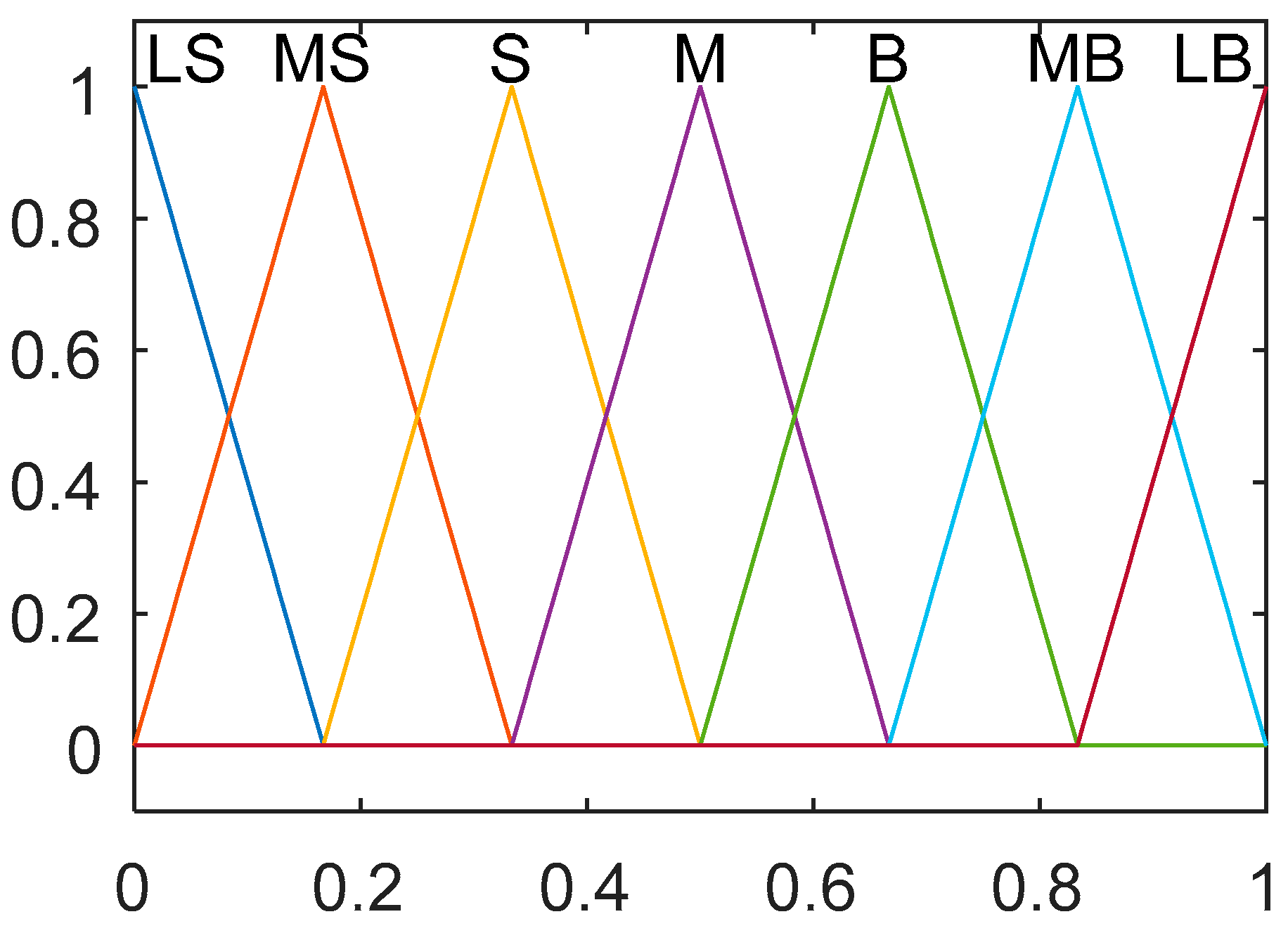

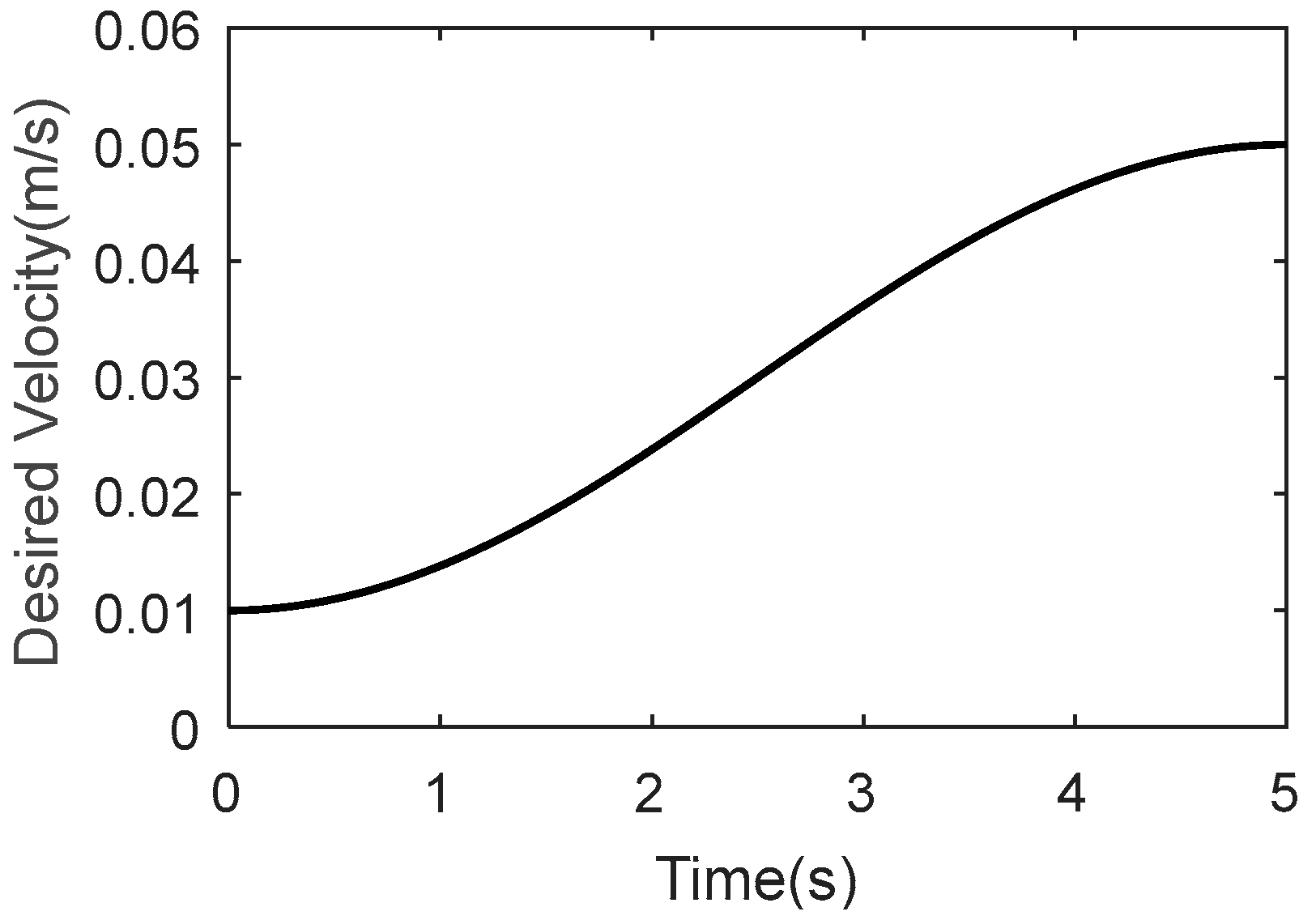




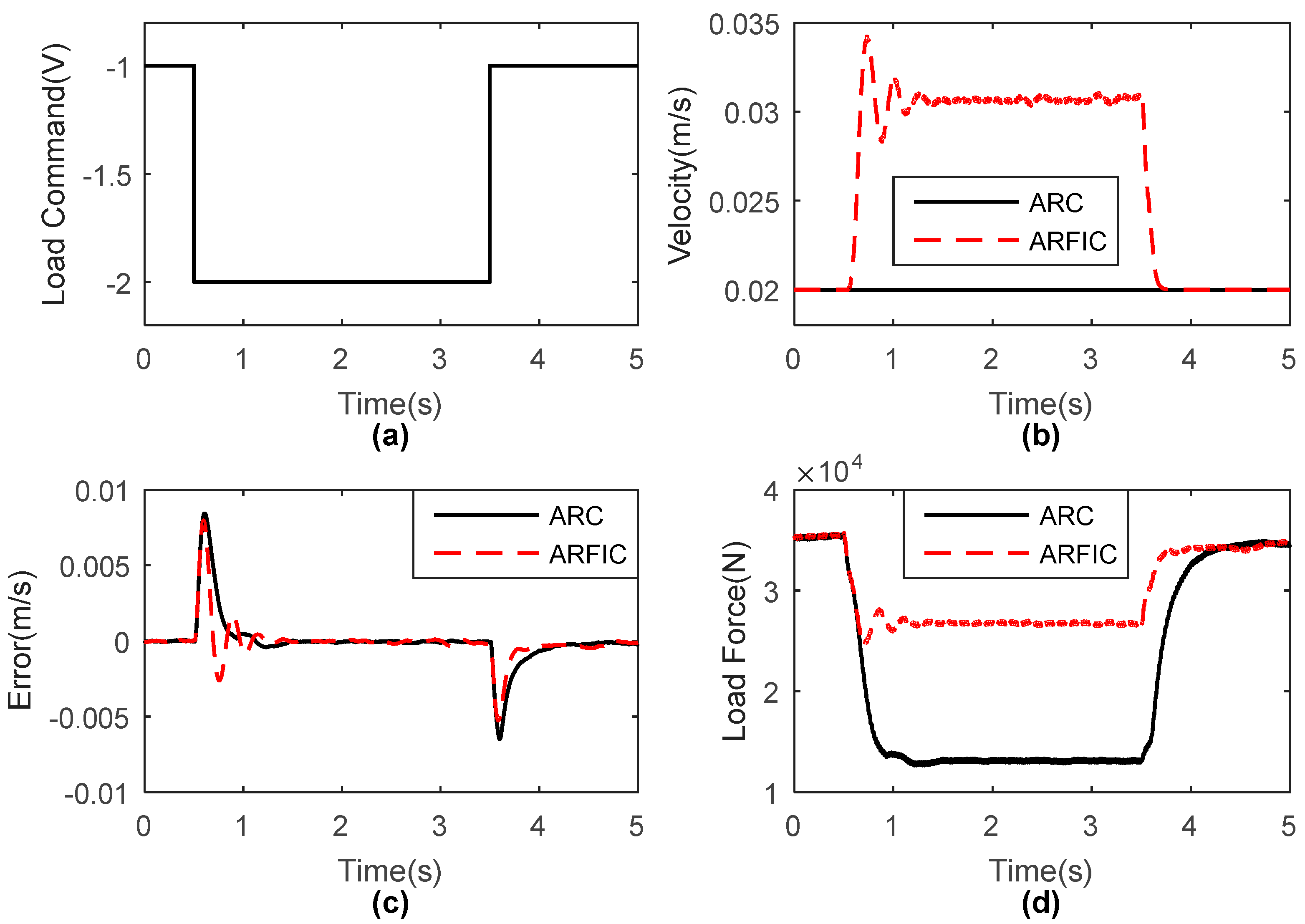
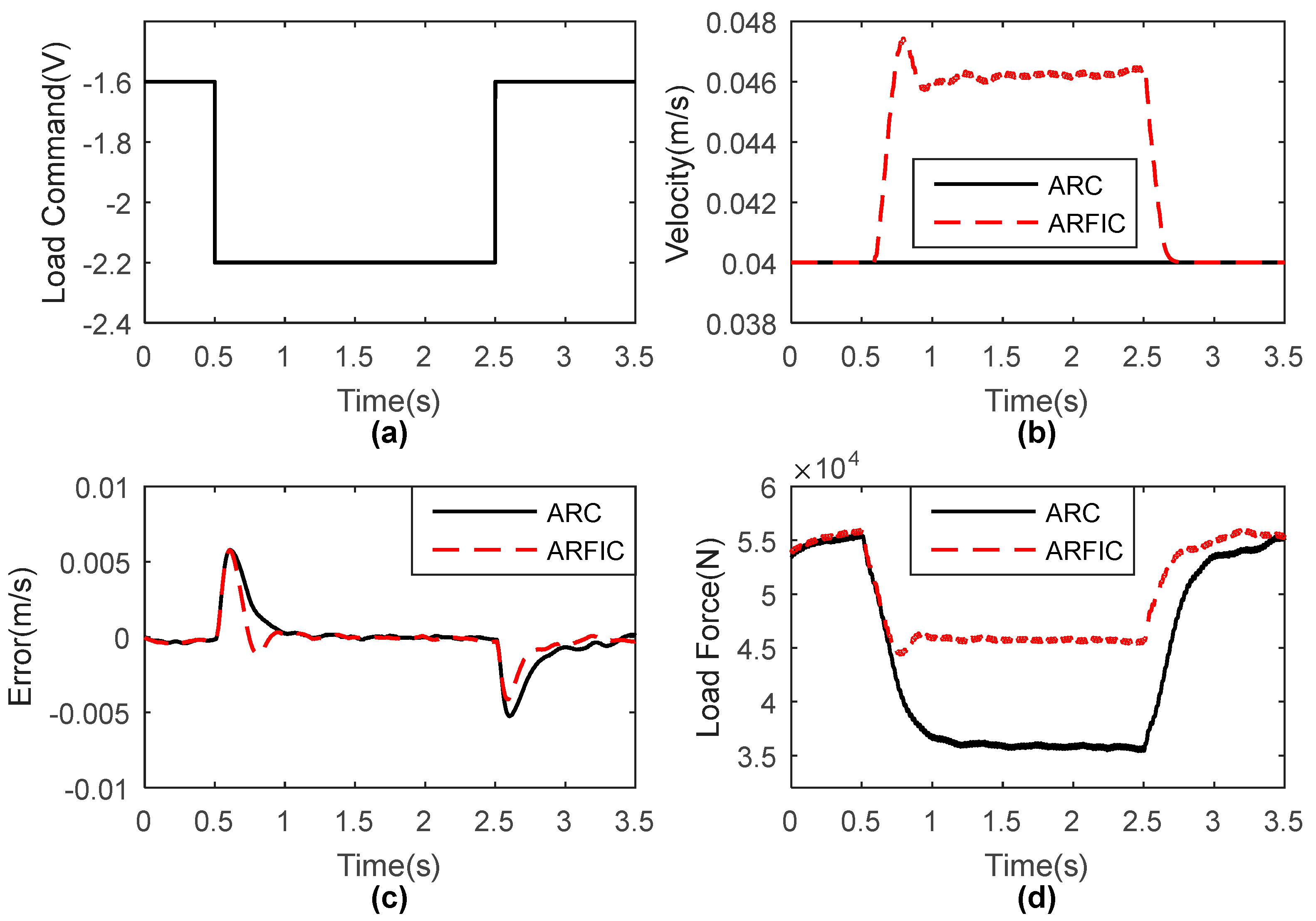
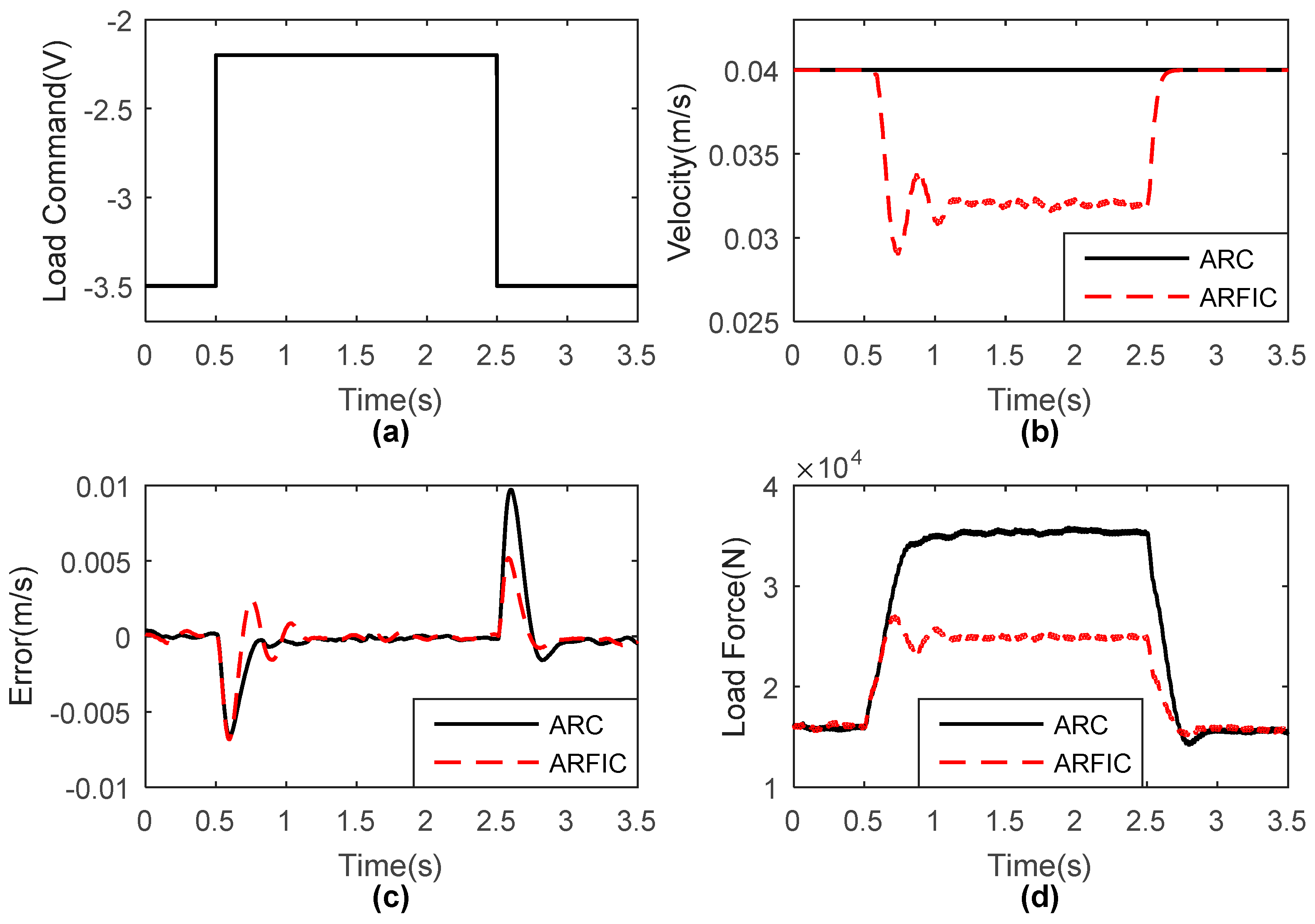
| LS | S | M | B | LB | ||
|---|---|---|---|---|---|---|
| LS | LB | LB | MB | B | M | |
| S | LB | MB | B | M | S | |
| M | MB | B | M | S | MS | |
| B | B | M | S | MS | LS | |
| LB | M | S | MS | LS | LS | |
| LS | S | M | B | LB | ||
|---|---|---|---|---|---|---|
| LS | LS | LS | MS | S | M | |
| S | LS | MS | S | M | B | |
| M | MS | S | M | B | MB | |
| B | S | M | B | MB | LB | |
| LB | M | B | MB | LB | LB | |
| Symbol | Value | Unit |
|---|---|---|
| Symbol (Unit) | Nominal Value | ||
|---|---|---|---|
| ) | |||
| ) | |||
| ) |
| Symbol | Value | Symbol | Value |
|---|---|---|---|
| Symbol | Value | Unit |
|---|---|---|
Publisher’s Note: MDPI stays neutral with regard to jurisdictional claims in published maps and institutional affiliations. |
© 2022 by the authors. Licensee MDPI, Basel, Switzerland. This article is an open access article distributed under the terms and conditions of the Creative Commons Attribution (CC BY) license (https://creativecommons.org/licenses/by/4.0/).
Share and Cite
Li, M.; Zhang, Q. Adaptive Robust Fuzzy Impedance Control of an Electro-Hydraulic Actuator. Appl. Sci. 2022, 12, 9575. https://doi.org/10.3390/app12199575
Li M, Zhang Q. Adaptive Robust Fuzzy Impedance Control of an Electro-Hydraulic Actuator. Applied Sciences. 2022; 12(19):9575. https://doi.org/10.3390/app12199575
Chicago/Turabian StyleLi, Mingjie, and Qiang Zhang. 2022. "Adaptive Robust Fuzzy Impedance Control of an Electro-Hydraulic Actuator" Applied Sciences 12, no. 19: 9575. https://doi.org/10.3390/app12199575
APA StyleLi, M., & Zhang, Q. (2022). Adaptive Robust Fuzzy Impedance Control of an Electro-Hydraulic Actuator. Applied Sciences, 12(19), 9575. https://doi.org/10.3390/app12199575





